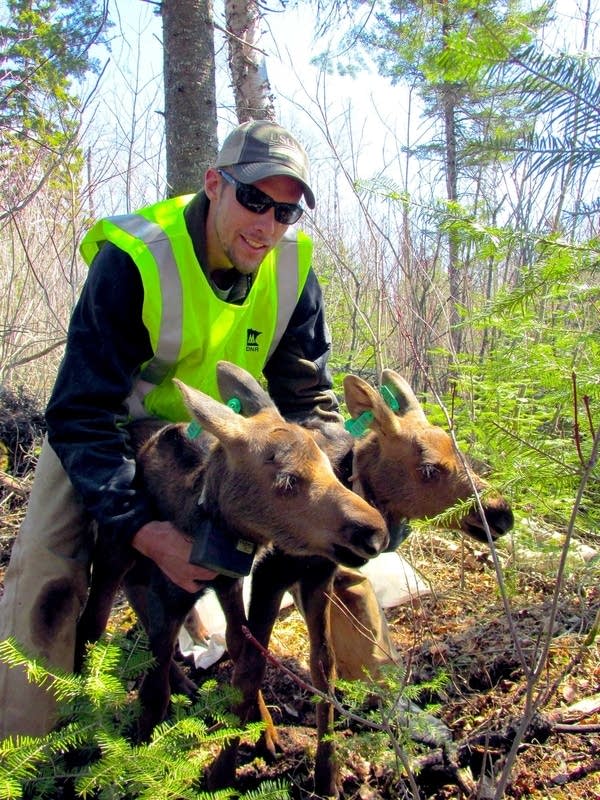DNR revises moose study after finding high rates of abandoned calves

Moose mothers have abandoned their calves at surprisingly high rates during the Minnesota Department of Natural Resource's ongoing study into the iconic animal's population decline in the northeast corner of the state.
But researchers have now found a way to place GPS collars on newborns that doesn't seem to lead to mothers leaving them behind.
• Previously: DNR collaring moose calves to study, protect species
Lead researcher Glenn DelGiudice said researchers now approach the calves in teams of two, rather than up to four people. And instead of collecting measurements and other data from the calves, which can take around four minutes, they now just slip the research collar on - a process that only takes a few seconds.
Create a More Connected Minnesota
MPR News is your trusted resource for the news you need. With your support, MPR News brings accessible, courageous journalism and authentic conversation to everyone - free of paywalls and barriers. Your gift makes a difference.
"We think we can do this very successfully with very minimal abandonment," he said, "if we keep the handling team to an absolute minimum, and get in there and out of there very quickly. And it's just worked really well."
The issue first surfaced in the spring of 2013, when the agency embarked on a landmark study to try to determine what's behind the collapse of the moose population in northeast Minnesota - from an estimated 8,800 animals in 2006, to about 4,300 this year.
Researchers placed GPS tracking collars on over 100 adult moose, and 49 moose calves, to be able to quickly respond to the animals when they died to identify exactly what killed it.

Of those 49 calves, nine were abandoned shortly after they were collared - a rate much higher than researchers had anticipated. The mothers often fled as soon as they heard the helicopter approach, DelGiudice said. That was surprising. In similar efforts in Alaska, scientists often had to use the helicopter to keep the mother away from the handler, he said, "because they were so aggressive in defense of their calves."
What was even more befuddling to researchers was that most of the mothers who ended up abandoning their calves returned to them, in some cases up to three times, sometimes even to nurse them, before ultimately leaving for good.
So, after consulting with other moose biologists around the country, DelGiudice decided that perhaps it was the helicopters that scared the mothers away. Starting May 8 this year, researchers began hiking to calves on foot, often bushwhacking through snow-covered bogs, after a period of up to two days to allow the calves and mothers to bond.
The researchers measured the calf's body weight, slipped the GPS collar on, affixed ear tags, measured the neck circumference and hind legs, took a rectal temperature, and left - all in about four minutes.
"We thought things were going smoothly," said DelGiudice. But after returning to their field station and monitoring the moose on computers, they found of the 12 calves they had collared, seven had been left by their mothers. "And we were like, what the heck is going on?" recalled DelGiudice. "It was really a mystery to us."
He was ready to put a stop to the project. But he tried one last ditch effort. They reduced the collaring teams to two people, and they didn't collect any data - rather they just slipped the GPS collars on, and left.
And it's worked. Between May 21 and June 2, DelGiudice said, they collared 10 calves, from eight different dams, or mothers, and none were abandoned. "That's a major success," he said.
Meanwhile of the seven calves that were abandoned, six were brought to the Minnesota Zoo. The seventh died before it could be recovered.
The remaining collared calves will be monitored as part of the DNR's ongoing mortality study. Of the 34 calves studied last year, 74 percent died, many killed by wolves, others by bears. In a healthy moose population, only about half die in their first year.
In addition to helping decipher what's killing Minnesota's moose, the calf study could also lead to unexpected scientific understanding of how to more safely capture moose and other animals for research. DelGiudice's team is preparing a manuscript for peer review on their findings. "What we're learning," he said, "could have very positive implications for other large mammal capture operations."
